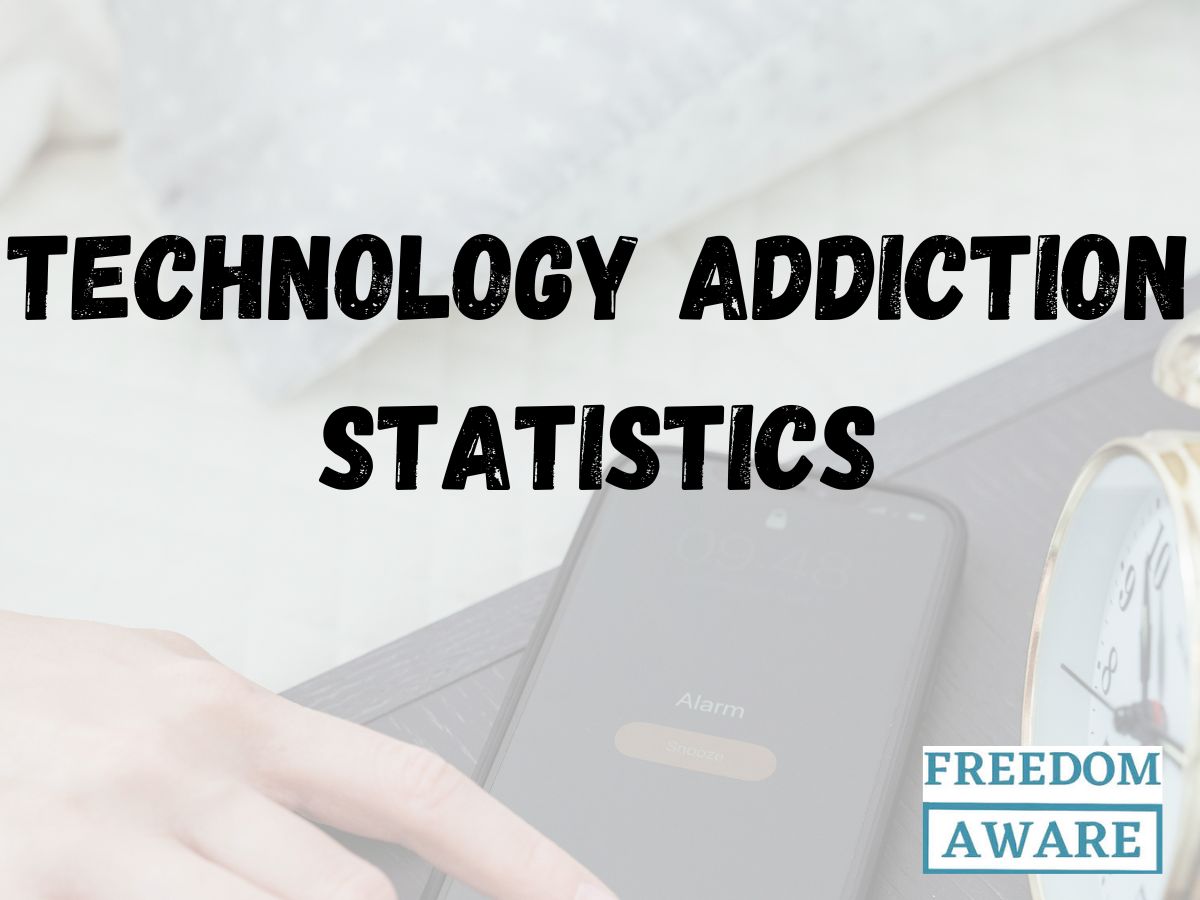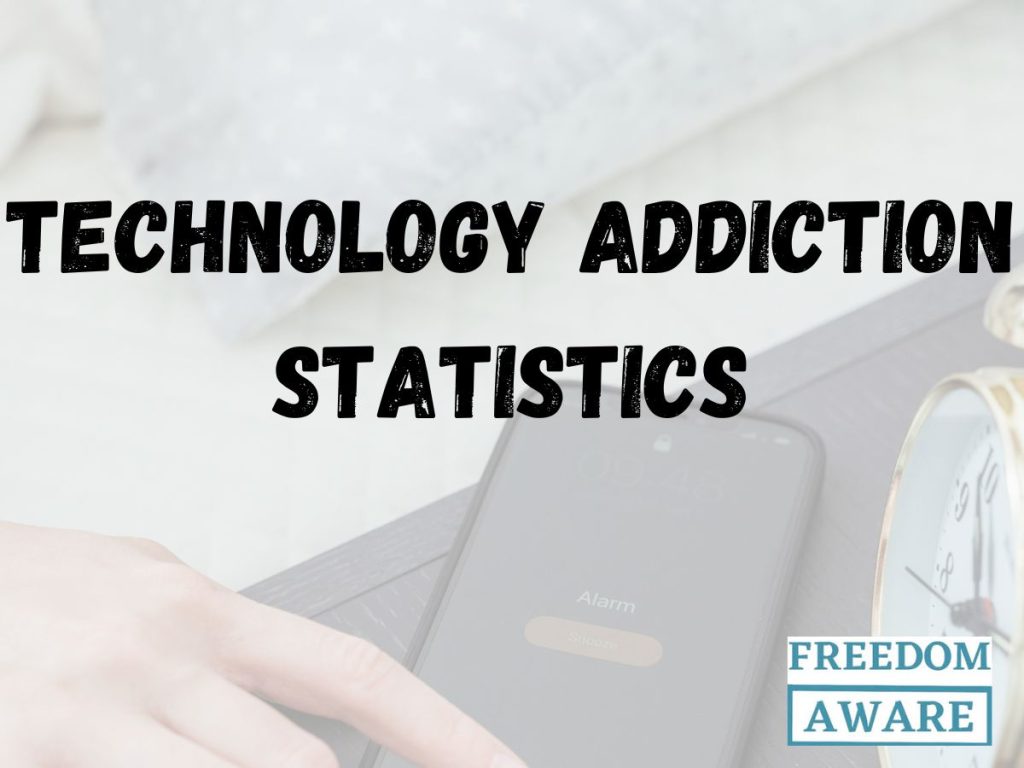
Here are 100+ most Important Technology Addiction Statistics to help you in 2024 and beyond:
Is your technology usage becoming an addiction?
Technology has become like a trusty companion in today’s world. It connects, informs, and keeps us entertained like never before. But with all this constant connection comes a growing concern: technology addiction. Technology addiction is a pervasive and rapidly growing problem with alarming statistics that highlight its severe impacts on individuals, relationships, and society as a whole. This article dives deep into a collection of eye-opening statistics on alarming technology addiction, revealing the widespread nature of our digital dependence and its significant effects on individuals, our relationships, and even society as a whole.
Technology Addiction Statistics ( Editor’s Pick)
- Screens Rule Our Lives: A study suggests the average American adult spends a whopping 44 years staring at screens.
- Phones Over People? A survey found that over half of people (54%) prefer their phones to spending time with their partner.
- Younger Generations Hit Hardest: A 2022 survey in Russia showed younger people are more susceptible to device and internet addiction.
- We Can’t Look Away: Americans check their phones a staggering 144 times a day on average.
- Phone Anxiety is Real: A survey revealed that a majority of teens (77%) experience anxiety when separated from their phones.
- We’re Hooked: A US survey found nearly half (48%) of internet users consider themselves addicted or somewhat addicted to their devices.
- How Widespread is Addiction? Studies suggest internet addiction affects between 1% and 10% of the population, based on prevalence studies conducted in 2022.
- 24 Hours Without a Phone? Unthinkable: Over half of Americans say they have yet to go a full day without their phone.
- Family Feuds Over Screens: According to 31% of parents, screen time is a top cause of parent-teenager arguments.
- Sleeping with Your Phone: A Qualtrics survey showed a whopping 79% of millennials sleep with their phones nearby, with over half (53%) waking up to check them at least once a night.
Digital Dependency Statistics (Technology Addiction Statistics)
- Smartphones steal a huge chunk of our daily screen time, averaging over 4 hours a day for adults. (source).
- Smartphone use is a major risk factor for teen drivers. More than one in five teen drivers in car accidents were using their phones when the crash occurred. (source).
- Our online activity has become almost as time-consuming as sleep, with an average person spending 42% of their waking hours connected to the internet. (source).
- The average UK citizen spends more time glued to screens than sleeping. (source).
- A third of us struggle to put our tech down. (source).
- Parents need help to limit their children’s technology use, with nearly half feeling their kids spend too much time on devices. (source).
- Nearly seven in ten (68%) American parents find themselves sidetracked by their phones when they’re with their kids. (source).
- Kids rack up an average of 44.5 hours of screen time each week. (source.)
- Adults in the US spend a staggering amount of time with their gadgets – over 6,259 hours a year. (source).
- Technology is causing friction in our relationships, with many couples arguing about screen time. (source).
- Believe it or not, 4 out of 10 adults admit to checking their phones in the bathroom. (source).
- The average American adult will spend 44 years of their life staring at screens. (source).
- We can’t even resist checking our smartphones within minutes of waking up. (source).
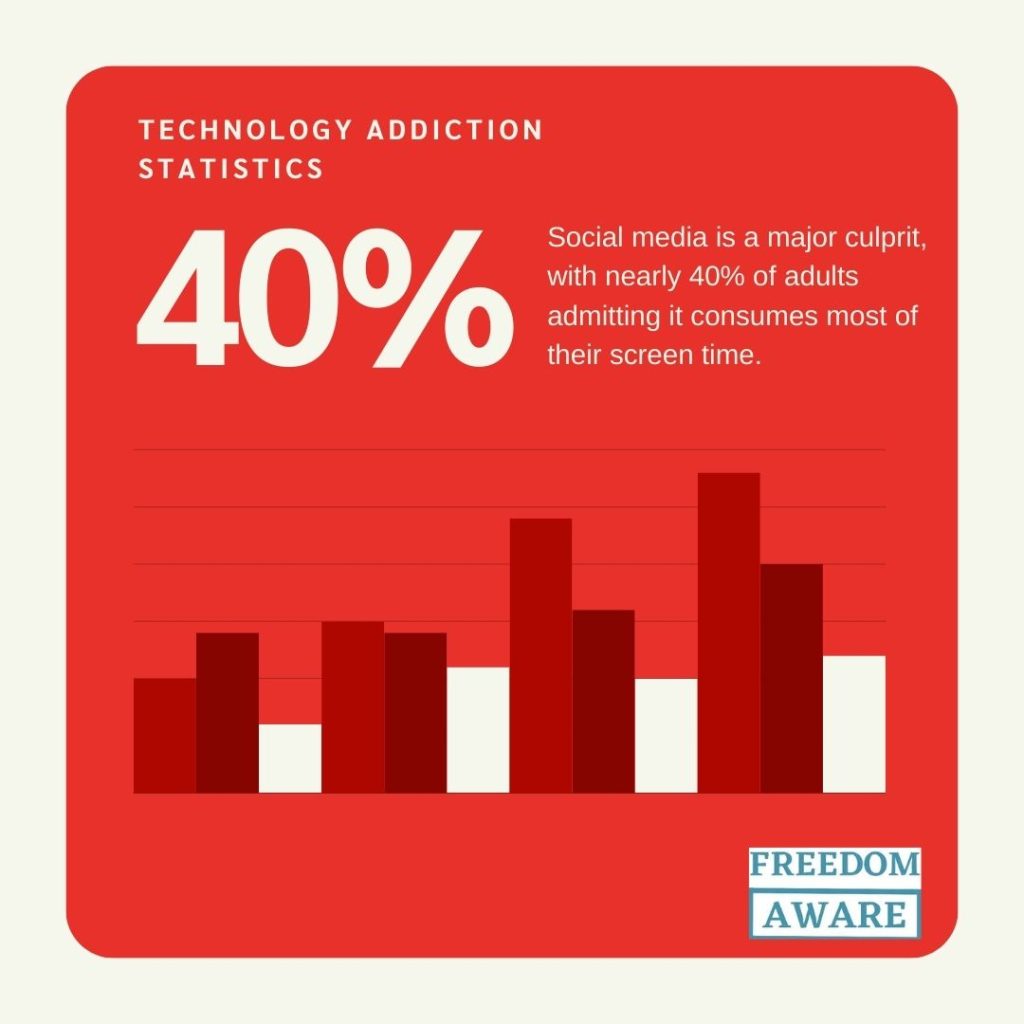
- Social media is a major culprit, with nearly 40% of adults admitting it consumes most of their screen time. (source).
- Watching TV and working are other common screen time activities, followed by online shopping. (source).
- Our eyes are suffering from all this screen time, with 70% of adults reporting eye strain. Yet, many of us don’t take breaks to rest our eyes. (source).
- We reach for our phones first thing in the morning, with most checking them within 10 minutes of waking up, and 60% doing so within 5 minutes. (source).
- On average, adults spend a significant amount of time watching TV, using laptops, and gaming each day. (source).
- Video games are particularly captivating, with roughly a quarter of teens feeling addicted. (source). This addiction is more prevalent in males.
- Teenagers are especially susceptible to smartphone addiction, with nearly half feeling hooked on their phones. (source).
- Nearly half of Americans consider themselves hooked on their devices. (source).
- It’s rude to check your phone while talking to someone, yet most of us do it. (source).
- People with more money struggle to disconnect from technology compared to those with less. (source).
- Most teenagers feel anxious without their phones, and many choose to sleep with them nearby. (source).
- Nearly half of teens (around 44%) struggle to disconnect from their devices, even when they know it is a good idea to take a break. (source).
- Muting your phone might backfire! Studies show that silencing notifications (no sound or vibrations) leads people to check their phones more often. (source).
- A December 2022 report by NDDC found that a concerning number of fatal crashes in the US involved distracted drivers using smartphones – somewhere between a quarter and a third. This translates to a tragic toll of over 3,100 deaths and more than 324,000 injuries. (source).
Technology Addiction Statistics By Country
- Most Americans can’t resist their phones. A whopping 75% check their devices within just five minutes of getting a notification. (source).
- Over a tenth of Americans (around 13%) believe they’d be significantly more productive without their smartphones around. (source).
- A 2019 survey in Poland found teenagers and young adults are especially prone to internet addiction. (source).
- South Korea takes the crown for smartphone ownership globally, boasting a staggering penetration rate of 98%. (source).
- A surprising study from Russia found that more than a third of people over 45 reported experiencing signs of addiction to their devices and the internet. (source).
- The internet is practically everywhere for UK adults, with a whopping 92% going online at home or on the go. From news and learning to fun and staying connected, the online world offers it all, blurring the lines between our physical and digital lives. (source).
- The internet is a constant presence for most Americans. A whopping 85% go online every day, with 31% practically living in cyberspace and another 48% checking their phones constantly. The remaining 6% join the digital world at least once daily. (source).
- In the U.K. the average person spends 8 hours and 41 minutes more time glued to their devices rather than sleeping, according to Ofcom’s 2023 Adults’ Media Use and Attitudes Report. (source).
- Nearly 99% of adults are online, the highest rate globally. (source).
- Canadians rack up nearly 8 hours and 20 minutes on social media every week. (source).
- A fifth of Brits (22%) admit to being hooked on TV, with a dedicated 7% saying they’re addicted. (source).
- Almost two out of five (37%) young French adults (18-34) freely admit they can’t resist their devices, they’re hooked. (source).
- Brits dedicate nearly 4 and a half hours (4 hours and 36 minutes) to online gaming each week. (source).
- Americans reign supreme when it comes to streaming movies, averaging a whopping 5 hours and 23 minutes glued to Netflix and other platforms every week. (source).
- More than half of Americans (57%) confessed their screen time ballooned by over an hour since the coronavirus lockdown. (source).
- Germans spend a significant chunk of their week glued to screens, averaging 5 hours and 19 minutes streaming videos and another 4 hours and 12 minutes on social media. (source).
- Among the countries analyzed Indonesia topped the list for daily smartphone usage, with users averaging 6.05 hours per day. This was significantly higher than Thailand (5.64 hours) and Argentina (5.33 hours). (source).
- The average Australian spends up to 9 hours and 14 minutes every week, after work. (source).
Smartphone Usage Statistics (Technology Addiction Statistics)
- There are currently 6.84 billion smartphone users globally, which is projected to climb to an estimated 7.1 billion by the end of 2024. In other words, smartphone use is rising, with nearly 7.1 billion users expected by year’s end. (source).
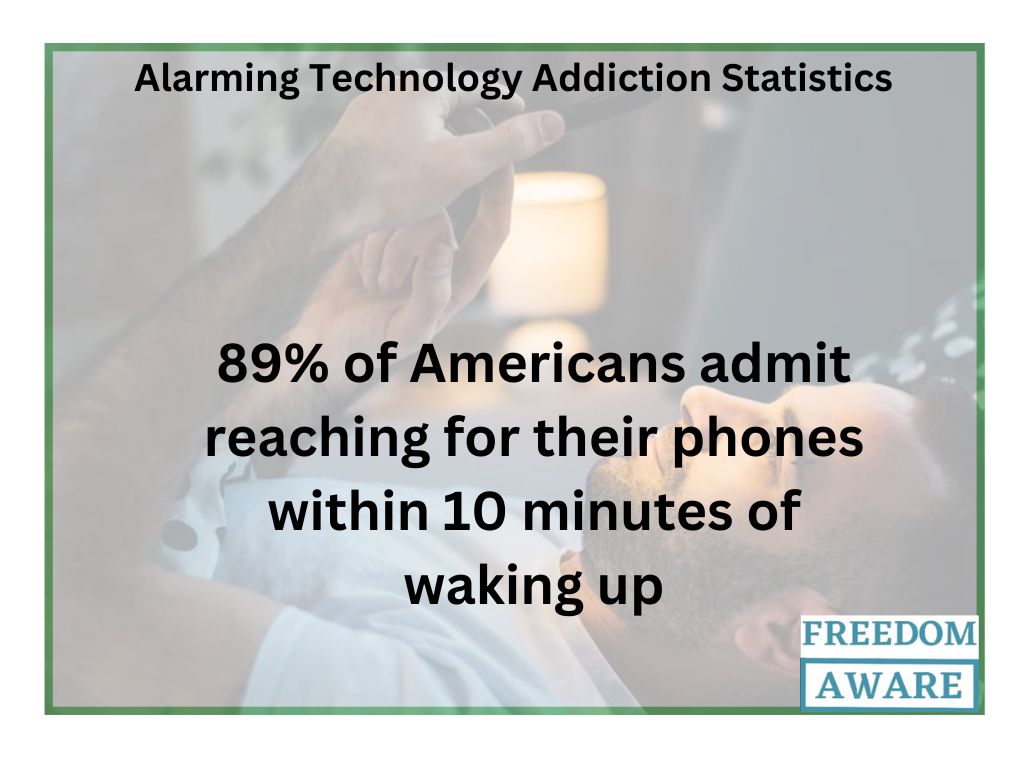
- Nearly nine in ten (89%) Americans admit reaching for their phones within 10 minutes of waking up. (source).
- 12% of adults use their smartphones in the shower. (source).
- The average internet user checks their phone 58 times daily. (source).
- A third (33%) of adults who use smartphones find themselves on a date with their device rather than a real person. (source).
- More than a third (35%) of moviegoers admit to using their phones during the film. (source).
- Our phones are constantly calling, the average internet user picks theirs up a staggering 58 times a day. (source).
- A significant portion (37%) of users reported a surge in texting since the COVID-19 pandemic began, exceeding their texting habits before. (source).
- Average smartphone users touch their phone 2,617 times per day. This does not include the time spent locking the phone. (source).
- 87% of smartphone users check their phones less than an hour before going to bed. (source).
- Phone addiction can significantly impact health habits. A study found that roughly 30% of those struggling with phone addiction exhibit unhealthy lifestyles, marked by increased consumption of fast food and decreased physical activity. (source).
- In the United States, 15% of adults rely solely on smartphones for their internet access. This means they have a smartphone but lack a home broadband subscription. (source)
- Twenty-seven percent of parents feel they are addicted to their mobile devices, while nearly the same number of teens, 28%, believe their parents are addicted, according to the poll. (source).
- On average time spent on smartphones among users in 20 markets included in the analysis reached 4.37 hours per day in 2023. (source).
- Smartphones account for 70% of digital media time in the United States. (source).
Social Media Addiction Statistics (Technology Addiction Statistics)
- Social media saw explosive growth in 2020, attracting an average of over 1.3 million new users every day. That’s like nearly 16 new users joining every single second. (source).
- Over 70% of adults from some countries use social media as a news source. These countries are the Philippines, Malaysia, South Africa, Kenya, and South Africa. (source).
- Two-thirds (63%) of Americans over 12 are on Facebook. (source).
- Social media use takes a toll on academic success for many young adults. A concerning 35.1% report suffering from poor academic performance due to their social media habits. (source).
- On average, individuals aged 16-24 spend about 2 hours and 50 minutes daily on social media, with higher usage linked to negative impacts on social well-being. (source).
- Nearly half (48%) of British teenagers who use social media platforms say they feel addicted to them. (source).
- More than half (55%) of drivers in the US confess to browsing social media behind the wheel, putting themselves and others at risk. (source).
- Overall, 34% of female internet users in the United States reported feeling addicted to social media. (source).
- Social media can be a paradox. It acts as a bridge aiming to connect us, yet research suggests it can also create a chasm of loneliness and isolation for those who spend too much time on it. (source).
- Facebook use emerges as a potential red flag in marital discord. Studies suggest it’s a factor in up to a third of disputes, potentially leading to divorce. This has spurred divorce lawyers to leverage social media data as evidence in court. (source).
- YouTube is the online video giant in the US, claiming a whopping 81% user base. (source).
- 40.6% of young adults complain their sleep has been affected by social media. (source ).
- Teenagers aren’t just seeking attention on social media – a study suggests “likes” trigger the same reward centers in their brains as getting money or enjoying chocolate. (source).
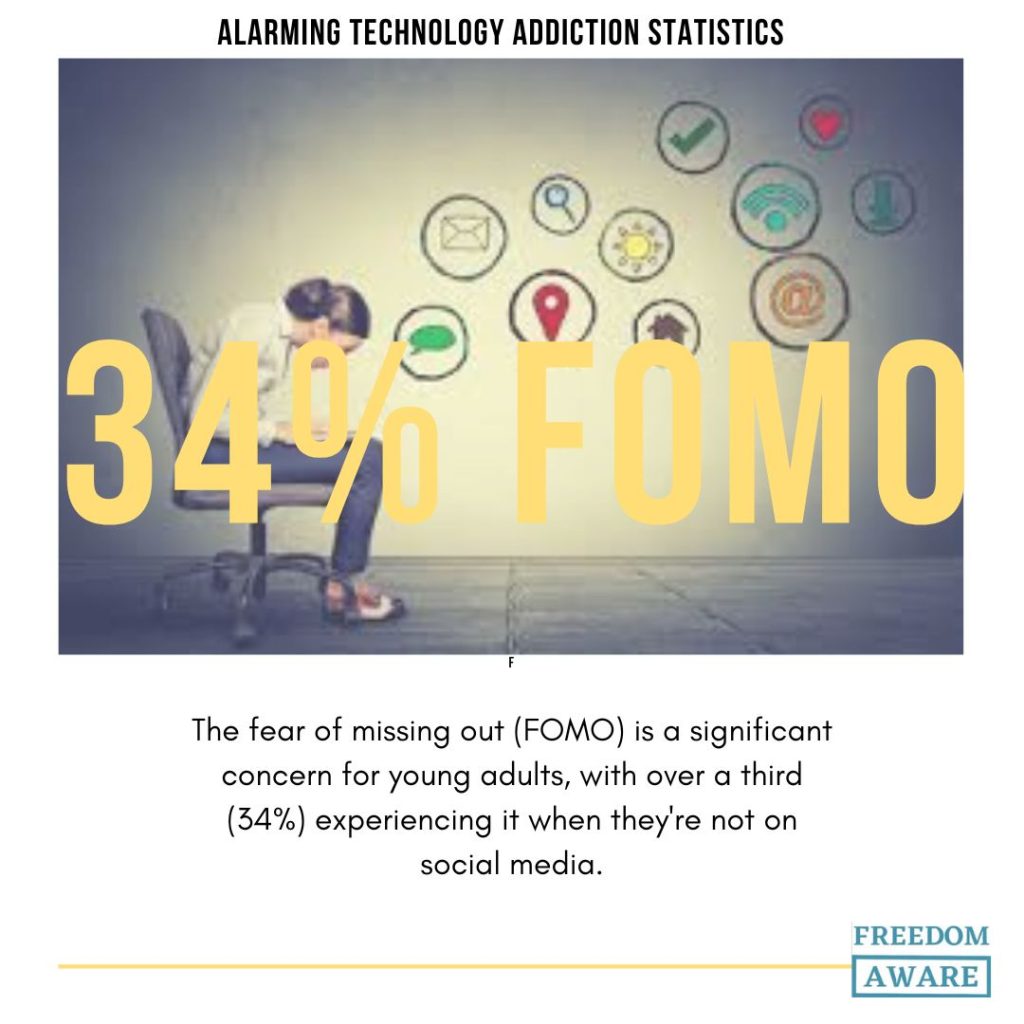
- The fear of missing out (FOMO) is a significant concern for young adults, with over a third (34%) experiencing it when they’re not on social media. (source).
- The cloak of anonymity offered by some platforms can create a breeding ground for harmful behavior, including cheating and sexual solicitation. (source).
- Social media presents a paradox for teens. While 80% feel more connected to their friends’ lives, a significant portion (38%) also grapple with overwhelming drama on these platforms. (source).
Internet Addiction (Technology Addiction Statistics)
- The COVID-19 pandemic saw a rise in problematic internet use, with about 33.37% of users developing unhealthy internet habits during this period. (source).
- A study revealed that over 4% of the students met the criteria for internet addiction, with an additional nearly 29% at risk of developing it. (source).
- 30% of employers have dismissed employees due to inappropriate internet behavior, often related to excessive social media use and online gaming. (source).
- Close to half (40%) of the population is estimated to deal with an internet-related compulsive disorder. (source).
- Nearly half (43%) of users experienced a dip in self-esteem when their social media posts received no likes or comments. (source).
- According to a study published in the International Journal of Neuropsychiatric Medicine, roughly 1 in 8 (12.5%) of Americans experience problematic internet use. This number can be even higher in some countries, reaching up to 30%. (source).
- While we lack data on technology use by age, internet user demographics offer valuable insights. In 2019, the 25-34 age group dominated internet users at 32%, followed closely by 18-24 year olds at 18%. Adults aged 35-44 also formed a significant portion at 19%. (source).
- A concerning number of people (35%) have been victims of cyberbullying. (source).
- Research from the University of Michigan suggests that a significant number of people globally, roughly 210 million, struggle with addiction to social media and the internet. (source).
- Image-based social media platforms like Instagram are significantly linked with body dysmorphia. (source).
- 9% of people have concealed their unnecessary internet activities from colleagues, friends, and relatives. (source).
- A study in Malaysia found that internet addiction is a concern for Chinese ethnicity respondents, with 34% reporting symptoms. (source).
- A significant portion of users experience physical problems due to their internet habits. These impairments include insomnia (26.8%), daytime sleepiness (20%), and eye strain (19%). (source).
Gaming Addiction (Technology Addiction statistics)
- The global video game community is thriving! With an estimated 3.09 billion active users, here’s a breakdown including projections for 2024 and yearly growth. (source).
| Year | Number of Gamers | Increase Over Previous Year | Increase Over Previous Year (%) |
| 2015 | 2.03 billion | – | – |
| 2016 | 2.17 billion | 140 million | ↑ 6.9% |
| 2017 | 2.33 billion | 160 million | ↑ 7.37% |
| 2018 | 2.49 billion | 160 million | ↑ 6.87% |
| 2019 | 2.64 billion | 150 million | ↑ 6.02% |
| 2020 | 2.81 billion | 170 million | ↑ 6.44% |
| 2021 | 2.96 billion | 150 million | ↑ 5.34% |
| 2022 | 3.09 billion | 130 million | ↑ 4.39% |
| 2023 | 3.22 billion | 130 million | ↑ 4.21% |
| 2024 | 3.32 billion | 100 million | ↑ 3.11% |
- In the US, with an estimated 150 to 231 million gamers and a worldwide gaming disorder prevalence of 1.96% to 3%, there could be up to 6.9 million people struggling with gaming disorder. (source).
- Studies indicate a higher prevalence of internet gaming disorder (IGD) among teenagers compared to teen females. (source).
- A significant portion of respondents (around one-third) reported marathon gaming sessions of five hours straight. This intense gaming behavior has increased by 13% compared to the 2020 survey. (source).
- Iran stands out with one of the world’s highest rates of video game addiction. A staggering 22.8% of the population is classified as addicted to various video games. (source).
- The global gaming community is booming! With over two billion active players currently, the industry is projected to reach a staggering three billion by 2023. (source).
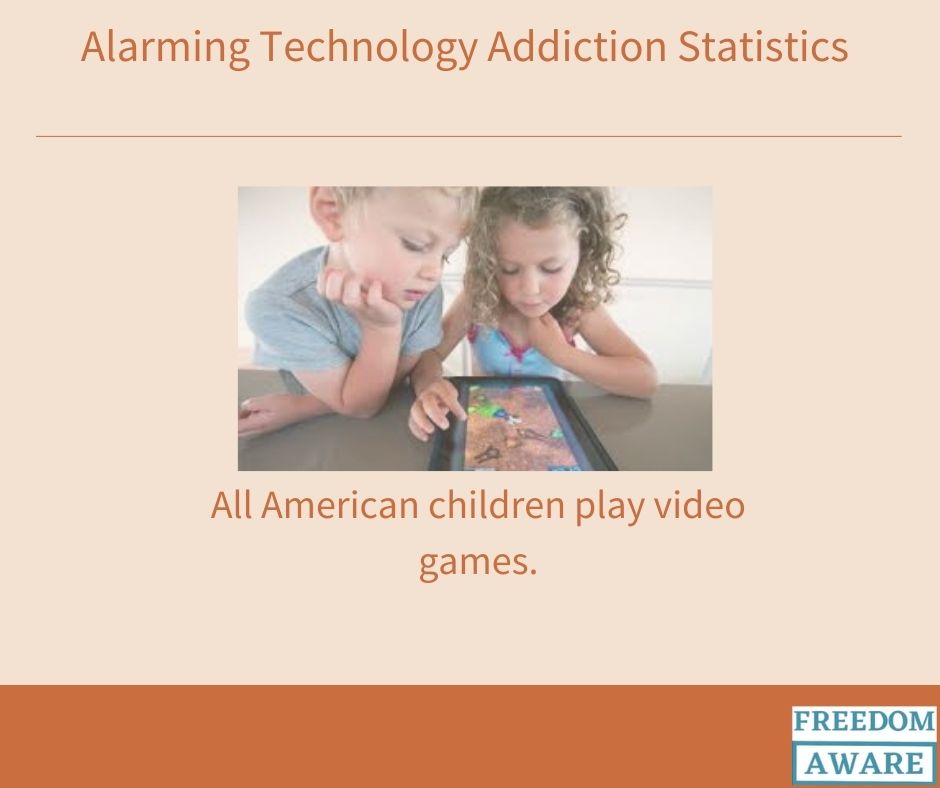
- 90-99% of all American children play video games. (source).
- High smartphone ownership and internet use are hallmarks of Japanese society. However, this widespread digital access has led to a concerning trend: gaming addiction among youth. (source).
- A 2017 study conducted by CAMH (The Centre for Addiction and Mental Health) in Canada raised concerns about video game addiction among university students in Ontario. The research found that nearly 12% of students exhibited signs of problematic gaming behavior. (source).
- A concerning trend in South Korea is the high prevalence of video game addiction. Research suggests that roughly 10% of the population may be addicted to video games. (source).
- 90% of gamers do not engage in behavior that is dangerous or has long-term consequences. (source).
- More than half of gamers (over 54%) sacrifice sleep due to their gaming habits. (source).
- The ease of access plays a role in the overlap between smartphone and video game addiction. With a vast library of gaming apps readily available, smartphones become a gateway to problematic gaming behavior. This is supported by the fact that 76% of users prefer mobile gaming. (source).
- The video game industry is a powerhouse, raking in nearly 347 billion U.S. dollars globally in 2022. Remarkably, mobile gaming reigns supreme, contributing a staggering 248 billion U.S. dollars to the total revenue. (source).
- A whopping 78% agree that playing online helps them forge new friendships and relationships. (source).
Tech Use: Are You Crossing the Line? (Technology Addiction Statistics)
Is your tech use becoming a problem? Here are some red flags to watch out for:
- Hiding Your Habit: Do you feel guilty or ashamed about how much time you spend on your devices? Are you secretive or dishonest about your tech use with family and friends?
- Tech Before All Else: Is your mental health suffering because of your tech habits? Do you experience increased anxiety, stress, depression, or irritability when you can’t use your devices?
- Tech as a Crutch: Do you rely on technology to feel good? Do you ever turn to electronic devices to feel better, feel more awake, or avoid dealing with things?
- The Need for More: Do you feel like you’re spending increasingly more time on your devices lately?
- Losing Interest in Life: Have your favorite hobbies or social activities fallen by the wayside because of your tech use?
- Knowing the Harm, Ignoring the Alarm: Are you aware of the negative consequences of your tech habits, but continue using devices anyway?
- The Urge to Use: Do you experience cravings or strong urges to use your devices, even when you know you shouldn’t?
- Risky Tech Use: Do you put yourself or others at risk by using your devices in dangerous situations, like driving or walking in traffic?
Why We Can’t Resist These Technology Tools (Technology Addiction Statistics)
- The Internet: The vast amount of information feeds a cycle of wanting to know more, keeping us hooked. We can now reach the internet from nearly anywhere, through computers, tablets, phones, and even watches. The fear of missing out (FOMO) is a common problem for young people who feel pressure to stay constantly connected. Social media platforms like Facebook can also become a crutch for those struggling with anxiety or depression. The internet is both easy and rewarding to use, making it hard to resist.
- Video Games: We naturally crave feelings of competence, independence, and connection. Challenging video games provide players with a sense of accomplishment. They also offer a wide range of choices, giving teens a feeling of control they might lack in other areas of life. Just like success in the real world, video games allow players to accumulate virtual wealth and prestige, which can translate into a kind of real-world recognition. Gamers can also connect with others who share their interests through online forums and communities. Similar to the internet, games are readily available on smartphones, keeping them constantly within reach. While games can offer social connection, they can also serve as an escape into a fantasy world where players can adopt new identities.
- Mobile Devices: These highly portable devices allow us to stay connected constantly. Smartphones, tablets, and other smart devices like smartwatches eliminate the need for a traditional computer, making it easier than ever to stay connected and complete tasks.
- Social Media: Social media platforms present personalized information in a user-friendly way, like a customized newsfeed or curated list of followers. Whether it’s a video call with family or a comment on a celebrity’s post, social media fulfills our need for human connection by allowing us to interact with people who might be far away. As social creatures, we crave connection for our emotional and mental well-being. Social media’s appeal lies in its ability to meet these needs without the effort or limitations of face-to-face interaction.
- The Growing Gamble: Online gambling is another red flag. With a wider range of betting apps and games readily available, and even gambling features integrated into online gaming, the ease of access is raising concerns. While gambling addiction isn’t new, having it just a tap or click away is a whole new ball game. (See more on Gambling Disorder)
- Retail Therapy Gone Wrong: Online shopping addiction, or online shopping/auction addiction, is the urge to compulsively shop online, even when it causes harm and disrupts your life. People with this addiction can’t resist the impulse to buy, leading to negative consequences.
- Clicking into Trouble: Problematic online pornography use describes the compulsive viewing of online sexual content that negatively affects your relationships and mental health.
How does technology addiction affect mental health? (Technology Addiction Statistics)
Technology addiction can have profound effects on mental health, often leading to a range of psychological issues that can significantly impair an individual’s quality of life. Some of the most common mental health impacts of technology addiction include:
- Anxiety: Constant connectivity and the fear of missing out (FOMO) can lead to heightened anxiety levels, as individuals feel compelled to check their devices frequently for updates, messages, or notifications.
- Depression: Excessive use of technology, particularly social media, can contribute to feelings of inadequacy, isolation, and depression. Comparing oneself to others and seeking validation through likes and shares can create a cycle of negative self-talk and low self-esteem.
- Sleep disturbances: The blue light emitted by screens can interfere with the body’s natural sleep-wake cycle, leading to insomnia, irregular sleep patterns, and poor sleep quality. Lack of restorative sleep can exacerbate existing mental health issues and contribute to cognitive decline.
- Impaired social skills: Overreliance on technology can result in diminished face-to-face social interactions, leading to difficulties in forming and maintaining healthy relationships. This can further contribute to feelings of loneliness and isolation.
- Cognitive decline: Prolonged exposure to digital devices can negatively impact attention span, memory, and problem-solving abilities. The constant barrage of information and the need for instant gratification can hinder the development of critical thinking and decision-making skills.
- Emotional dysregulation: Technology addiction can interfere with an individual’s ability to regulate their emotions, leading to impulsivity, irritability, and mood swings. This can further contribute to the development and exacerbation of mental health issues.
As technology continues to permeate our daily lives, it is crucial to recognize the potential mental health impacts of addiction and seek strategies to maintain a healthy balance between our digital and real-world experiences.
How to Prevent and Treat Tech Addiction (Technology Addiction Statistics)
- Breaking the Cycle: Set clear limits on your screen time each day or week, and stick to them! This will help you reclaim control of your time.
- Unplug and Recharge: Make time for activities that don’t involve screens. Spend time with loved ones, exercise, or rediscover old hobbies. Give your mind and body a break!
- Knowledge is Power: Learn about the potential downsides of excessive tech use, especially for younger people. Raise awareness about the risks and consequences.
- Be Tech Savvy: Develop healthy digital habits. Learn how to use technology safely and responsibly. Identify and avoid behaviors that might lead to addiction.
Breaking Free: Treatment Options (Technology Addiction Statistics)
- Talk it Out: Cognitive Behavioral Therapy (CBT) can help you identify and change negative thoughts and behaviors around technology use. A therapist can guide you through this process.
- Find Your Tribe: Support groups offer a safe space to share your experiences and learn from others struggling with tech addiction. You’re not alone!
- Help at Your Fingertips: Many online resources can help, including self-help websites and apps. Find tools and guidance to support your journey towards healthier tech habits.
- Considering Medication: In some cases, medication might be prescribed to manage anxiety or depression that could be contributing to your tech addiction. A healthcare professional can advise you on this.
Conclusion (Technology Addiction statistics)
There’s no one-size-fits-all solution. The best treatment plan for you will depend on your individual needs. Consider seeking professional help from a therapist or counselor specializing in technology addiction treatment. They can create a personalized plan to help you regain control of your tech use.

